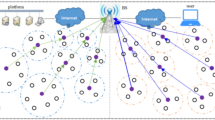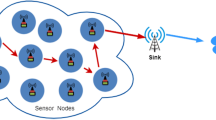Abstract
This paper proposes an approach called PC-CORP (Power Control based Cooperative Opportunistic Routing Protocol) for WSN (Wireless Sensor Networks), providing robustness to the random variations in network connectivity while ensuring better data forwarding efficiency in an energy efficient manner. Based on the realistic radio model, we combine the region-based routing, rendezvous scheme, sleep discipline and cooperative communication together to model data forwarding by cross layer design in WSN. At the same time, a lightweight transmission power control algorithm called PC-AIMD (Power Control Additive Increase Multiplicative Decrease) is introduced to utilize the cooperation of relay nodes to improve the forwarding efficiency performance and increase the robustness of the routing protocol. In the simulation, the performance of PC-COPR is investigated in terms of the adaptation of variations in network connectivity and satisfying the QoS requirements of application.
Similar content being viewed by others
References
Y. Xu, J. Heidemann, and D. Estrin. Geography-informed energy conservation for ad hoc routing. Proc. MobiCom 2001, Rome, Italy, July 16–21, 2001, 70–84.
B. Chen, K. Jamieson, H. Balakrishnan, and R. Morris. Span: an energy-efficient coordination algorithm for topology maintenance in ad hoc wireless networks. Proc. MobiCom 2001, Rome, Italy, July 16–21, 2001, 85–96.
F. Koushanfar, A. Davare, D. Nguyen, M. Potkonjak, and A. Sangiovanni-Vincentelli. Low power coordination in wireless ad-hoc networks. International Symposium on Low Power Electronics and Design (ISLPED), Seoul, Korea, August 25–27, 2003, 475–480.
C. Schurgers, V. Tsiatsis, S. Ganeriwal, and M. Srivastava. Optimizing sensor networks in the energy-latency-density design space. IEEE Transactions on Mobile Computing, 1(2002)1, 70–80.
J. Van Greuen, D. Petrović, A. Bonivento, J. Rabaey, K. Ramchandran, and A. Sangiovanni-Vince-ntelli. Adaptive sleep discipline for energy conservation and robustness in dense sensor networks. ICC’2004, Paris, France, June 20–24, 2004, Vol. 6, 3657–3662.
A. Bonivento, C. Fischione, and A. Sangiovanni-Vincentelli. Randomized protocol stack for ubiquitous networks in indoor environment. CCNC’2006, Las Vegas, NV, Jan 8–10, 2006, Vol.1, 152–156.
E. Lin, A. Wolisz, and J. Rabaey. Power efficient rendezvous schemes for dense wireless sensor networks. ICC’2004, Paris, France, June 20–24, 2004, Vol.7, 3769–3776.
M. D. Yarvis, et al. Real world experiences with an interactive ad hoc sensor network. Proceedings of the International Workshop on Ad Hoc Networking (IWAHN), Vancouver, Canada, Aug. 18–21, 2002, 143–151.
D. Tse and S. Hanly. Multi-access fading channels: Part I: Polymatroid structure, optimal resource allocation and throughput capacities. IEEE Transactions on Information Theory, 44(1998)7, 2796–2815.
R. C. Shah, A. Bonivento, D. Petrovi’c, E. Lin, J. Van Greuen, and J. Rabaey. Joint optimization of a protocol stack for sensor networks. MILCOM’2004. Monterey, CA, Oct.31–Nov.3, 2004, Vol.1, 480–486.
M. Zorzi and R. R. Rao. Geographic Random Forwarding (GeRaF) for ad hoc and sensor networks: multihop performance. IEEE Transactions on Mobile Computing, 2(2003)4, 349–365.
R. Jain, A. Puriactions, and R. Sengupta. Geographical routing using partial information for wireless ad hoc networks. IEEE Personal communications, 8(2001)1, 48–57.
D. Ganesan, R. Govindan, S. Shenker, and D. Estrin. Highly-resilient, energy-efficient multipath routing in wireless sensor networks. ACM Mobile Computing and Communications Review, 5(2001)4, 11–25.
S. Floyd, V. Jacobson, C. Liu, and L. Zhang. A reliable multicast framework for light-weight sessions and application level framing. IEEE/ACM Transactions on Networking, 5(1997)6, 784–803.
J. N. Laneman and G. Wornell. Energy-efficient antenna sharing and relaying for wireless networks. IEEE Wireless Communications and Networking Conference, Chicago, IL, USA, September 27–29, 2000, Vol.1, 7–12.
J. N. Laneman and G. Wornell. Exploiting distributed spatial diversity in wireless networks. Allerton Conference on Communications, Control, and Computing, Allerton Park, IL, USA, October 4–7, 2000, 775–784.
Martin Mauve, Holger Füßler, Jörg Widmer, and Thomas Lang. Poster: Position-based multicast routing for mobile ad-hoc networks. ACM Mobi-Hoc’03, Annapolis, MD, USA, June 1–3, 2003, 53–55.
Brad Karp and H. T. Kung. GPSR: Greedy perimeter stateless routing for wireless networks. Proceedings ACM/IEEE MobiCom, Boston, Massachusetts, USA, August 6–11, 2000, 243–254.
Sanjit Biswas and Robert Morris. Opportunistic routing in multi-hop wireless networks. Computer Communication Review, 34(2004)1, 69–74.
D. Kotz, C. Newport, and C. Elliott. The mistaken axioms of wireless network research. Technical Report TR2003-467, Department of Computer Science, Dartmouth College, July 2003.
G. Zhou, T. He, S. Krishnamurthy, and J. Stankovic. Impact of radio irregularity on wireless sensor networks. MobiSys’04, Boston, MA, USA, June 6–9, 2004, 125–138.
M. Zuniga and B. Krishnamachari. Analyzing the transitional region in low power wireless links. IEEE SECON’2004, Santa Clara, Canada, Oct. 4–7, 2004, Vol.1, 517–526.
Marco Zuniga and Bhaskar Krishnamachari. An analysis of unreliability and asymmetry in low-power wireless links. ACM Transactions on Sensor Networks, 3(2007)2, article 7.
Shan Lin, Jiangbin Zhang, Gang Zhou, Lin Gu, Tian He, and John A. Stankovic. ATPC: Adaptive transmission power control for wireless sensor networks. Fourth ACM Conference on Embedded Networked Sensor Systems (SenSys’ 2006), New York, NY, USA. October 31–November 3, 2006, 223–236.
D. Son, B. Krishnamachari, and J. Heidemann. Experimental study of the effects of transmission power control and blacklisting in wireless sensor networks. IEEE SECON’2004, Santa, Clara, CA, October 4–7, 2004, 289–298.
En-Yi Lin and Jan M. Rabaey. A comprehensive study of power-efficient rendezvous schemes for wireless sensor networks. [Ph.D. Dissertation], University of California, Berkeley, 2005.
N. Ahmed, S. S. Kanhere, and S. Jha. Probabilistic coverage in wireless sensor networks. Proceedings of IEEE Conference on Local Computer Networks (LCN’05), Sydney, Australia, November 15–17, 2005, 672–681.
Author information
Authors and Affiliations
Corresponding author
Additional information
Supported by 973 Program (2007CB310607), National Natural Science Foundation of China (60772062) and the Open Research Fund of National Mobile Communications Research Laboratory, Southeast University (N200813).
Communication author: Hu Haifeng, born in 1973, male, Lecturer.
About this article
Cite this article
Hu, H., Zhu, Q. Power control based cooperative opportunistic routing in wireless sensor networks. J. Electron.(China) 26, 52–63 (2009). https://doi.org/10.1007/s11767-007-0095-z
Received:
Revised:
Published:
Issue Date:
DOI: https://doi.org/10.1007/s11767-007-0095-z




